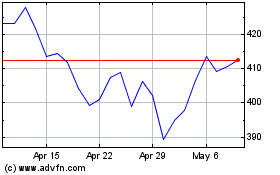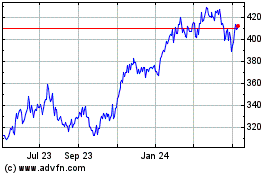U.S. Covid-19 Supercomputing Group Evaluates Year-Long Effort
March 24 2021 - 1:45PM
Dow Jones News
By Sara Castellanos
Researchers working on nearly 100 projects related to Covid-19
around the globe have had free access to some of the world's most
powerful computers in the past year, courtesy of a consortium led
in part by the U.S. government and technology companies.
Members of the Covid-19 High-Performance Computing Consortium on
Tuesday spoke on the progress of their initiative and advocated for
a formal organization that would be in charge of making computing
resources available in the event of future pandemics, hurricanes,
oil spills, wildfires and other natural disasters.
"The consortium is proof we were able to act fast and act
together," said Dario Gil, senior vice president and director of
the research division of International Business Machines Corp., who
helped create the consortium.
Announced in March of last year, the consortium has 43 members,
including IBM, the national laboratories of the Department of
Energy, Amazon.com Inc.'s Amazon Web Services, Microsoft Corp.,
Intel Corp., Alphabet Inc.'s Google Cloud and Nvidia Corp.
Collectively, the group helped researchers world-wide gain
access to more than 600 petaflops of computing capacity, plus more
than 6.8 million compute nodes, such as computer processor chips,
memory and storage components, and over 50,000 graphics-processing
units.
Among the nearly 100 approved projects was one in which
researchers at Utah State University worked with the Texas Advanced
Computing Center, part of the University of Texas at Austin, and
others to model the way virus particles disperse in a room. The
goal was to understand the distribution of Covid-19 virus particles
in an enclosed space.
Researchers from the University of Tennessee, Knoxville worked
with Google and Oak Ridge National Laboratory on another project to
identify multiple already-approved drug compounds that could
inhibit the coronavirus. Two of them are currently in clinical
trials.
Members of the group reviewed more than 190 project proposals
from academia, healthcare organizations and companies world-wide,
approving 98. The projects were chosen based on scientific merit
and need for computing capacity by representatives from the
consortium with backgrounds in areas such as high-performance
computing, biology and epidemiology.
The results of many of these studies were used to inform local
and regional government officials, said John Towns, executive
associate director of engagement at the National Center for
Supercomputing Applications, part of the University of Illinois at
Urbana-Champaign. "A number of these things were being used as
supporting evidence for decision makers," said Mr. Towns, who is
also a member of the consortium's executive committee.
The consortium is still accepting applications for projects.
The group is now advocating for a formal entity called the
National Strategic Computing Reserve to accelerate the pace of
scientific discovery in future times of crisis. The organization
would enable access to software expertise, data and computing
resources that can be used by researchers. Federal officials would
have to enact a law to approve such an organization and grant it
funding.
"Computing and data analysis will play an increasingly important
role in addressing future national emergencies, whether they be
pandemics or other events such as future pandemics, tornadoes,
wildfires or nuclear disasters," said Manish Parashar, director of
the office of advanced cyberinfrastructure at the National Science
Foundation, and a member of the consortium's executive
committee.
Write to Sara Castellanos at sara.castellanos@wsj.com
(END) Dow Jones Newswires
March 24, 2021 14:30 ET (18:30 GMT)
Copyright (c) 2021 Dow Jones & Company, Inc.
Microsoft (NASDAQ:MSFT)
Historical Stock Chart
From Mar 2024 to Apr 2024

Microsoft (NASDAQ:MSFT)
Historical Stock Chart
From Apr 2023 to Apr 2024
